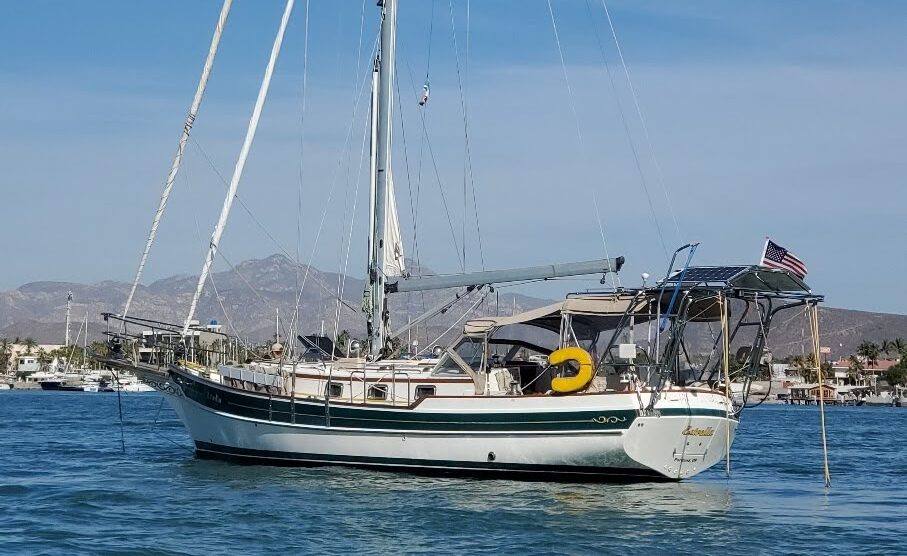
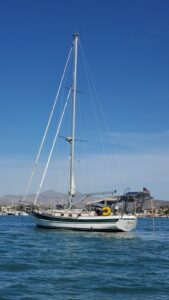 This was an overnight shake down to see how the crew would work and if all Estrella systems were go for a 28 to 32 day Pacific crossing. This was all motoring, using valuable fuel which I would replace at my jump off point in Los Cabos, the bottom of Baja and the Baja jump off point for the South Pacific.
This was an overnight shake down to see how the crew would work and if all Estrella systems were go for a 28 to 32 day Pacific crossing. This was all motoring, using valuable fuel which I would replace at my jump off point in Los Cabos, the bottom of Baja and the Baja jump off point for the South Pacific.
*Uh-oh*
Once again, checking all systems, everything looked good, except for an odd release of foamy primary coolant from the engine air bleed valve that is on top of the engine thermostat housing. My particular primary cooling system requires me to check for gas of any kind getting trapped in the engine primary cooling circuit (I may do a write on this later).
Normally, I get about 3 seconds of gas/air then clean coolant. This time I got 15 seconds of foamy water and not particularly clear water.
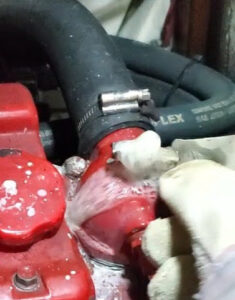
I thought about purging the primary system and putting new water and primary coolant additives but decided to wait and check again at Los Cabos.
The rest of the stay at Frailes was uneventful.. Crew went swimming, ate dinner and surfed the web. Anchorage was getting Pacific swell and was a bit rolly (so much more to come!)
*Los Cabos *
I topped of the tanks in Los Cabos. Fully fueled with 45 G in the main 17 G in the reserve and 20 G in jerry cans. That gave me about 80 G usable.
Checking the primary coolant bleed valve was not good. More foam.
My first thought was that I had a blown head gasket. I did not want to risk going to sea with a questionable motor. Crew was pressing me to go. Not a good sign.
I turned back. Deciding to stop at Frailes and purge the primary coolant, flush the motor and put new, clean water and coolant additive back in.
As a side note, I had been planning this trip for over a year. If I could have done things wrong during this process of planning, e.g. preparing the boat, getting the LTS visa etc, I found the wrong thing to do. Nearly every step of the way was a do over, re do, delay or in retrospect a decision that could have gone better. This engine issue certainly can be included in this bizarre, stressful effort.
*Frailes again*
I gave the probability of doing the crossing at 50-50. La Paz was in my sights. Reaching Frailes, the crew goes swimming, eats dinner and surfs the web. I rest in this rolly anchorage. The next morning I drained the primary coolant which, due to modifications made several years ago, was very easy. Then it used my precious RO water to purge the system. I got help from the crew here as he watched for the water as it cleared up. Ran the engine up and down, purged again and did a final fill with new coolant.
After running the engine up to temperature, I found the normal bleed letting gas/air out and beautiful clear coolant.
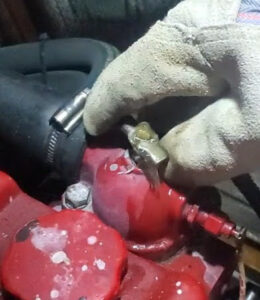
The trip was on. I would check again in six hours of engine run time to see if I had gassy coolant. Due to the return trup to Frailes and then departure from Failes I used precious fuel. About 6 gallons out of my 80 and we had not even started.
*6 hours* The bleed valve produced 3 seconds of gas/air and clean coolant.
*NW winds, swell from every direction*
I finally got out of the Baja wind shadow. Wind was from the WNW. I could barely keep southing going as the seas were very uncomfortable. Maintaining 5 knots with swell crashing over the toe rail flooding the gunnels, was a challenge. With these winds I was not going to make way to Clarion island, the last land fall possible before the South Pacific. This lasted two days.
One notable event was a south west breaking wave that broke on my starboard bow. A tanker truck full of water came rushing down the deck, diverted by my hard dodger over the top of the bimini. But not before blowing out seams on my starboard cockpit canvas and putting 2 inches of water into the cockpit. Fortunately nothing got into the cabin. I put up my batter boards!
With all this southing, I chose to aim for Benedict Island. My best chance for a rest and a place to repair my canvas.
*Light winds form the NE*
With better wind direction, I took aim at Clarion. It was to be motor sailing. I felt I really needed some westing to hit my 9′ N 10′ west entrance to the ITCZ. This meant burning still more precious fuel before I was even 1/4 of the way.
Being very late in the season (last boat of the fleet that left in April) the ITCZ was much further north and very active to the east. This required I find a narrow slot accross the ITCZ, not to far west as to miss the Marquesses but not to far east to get into the SW vector of the southern trades (which would push me even further east. Thank goodness for Starlink, Predict Wind and NOAA band 14 East Pacific sat image. Regular updates showed clearly a path with deteriorating SE trades south of the ITCZ.
This is a rocky island with a south facing harbor. There is a Mexican military outpost on the hill side. Technically I am not supposed to come in and anchor, however, the Mexican military are friendly. Speaking very bad Spanish I managed to talk to a woman marina who spoke bad english and we got permission to anchor for one night as long as we did not leave the boat.
Taking advantage of the lee side of island in a relatively calm bay, I pulled out my sewing machine and took down the four panels that needed repair. Two hours later I had the panels back up!
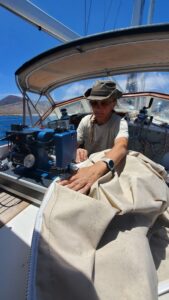
I cooked up some pork chops and potatoes for dinner. Crew ate and surfed the web.
Crew began demanding we go faster to avoid a ‘hurricane’ predicted two weeks out. Two week predictions on the GFS model are useless. The EU model did not show any tropical storm development. Still Crew was not happy.
*SW to 9’N 120’W* T
he seas were finally being consistent, though 2 meters and up swell from the NW (so on the beam) was not comfortable. The winds shifted to the NE and it was a broad reach with more westing than I would have liked. Days and days of this.
Batteries and solar clearly could not keep up with Max, the autopilot. During the day the solar panels would keep up but not enough to charge the battery overnight.
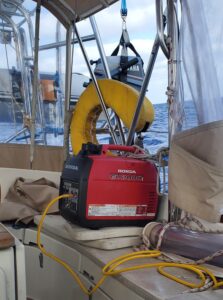
To compensate I began using my honda generator and the engine for some strategic motor sailing and charging at the same time. The most opportunistic times were between late in the day and day break. Every couple of days I would run 2 to 4 hours which was enough to top off the batteries and let me run a night without recharging.
About this time, I began to notice that the watermaker was not producing as much product as it was at the beginning of the trip. Requiring that I run it for longer periods of time. This also would impact my battery charge and fuel consumption. Although the PPM was a little high the water was still healthy to drink.
*ITCZ at 9’N 121′ W*
Crew still concerned we were not out of the tropical depression zone (north of 5′ N) even though the season literally just began (May 15).

Th ITCZ was narrow. We had half a day of doldrums, a little drizzle, and easterly winds with calm seas. It was the best day and night of sailing that we had.
Lots of boobies shitting all over the dinghy and bow rail.
*The Brick Wall*
At 5′ N 122’W I hit the southerly trades that were coming straight south into the ITCZ (a couple of days later there were huge thunderstorms where we crossed). This coupled with a strong current heading south made it impossible to get any southing at all. I hove to for the night.
Next morning, after reviewing Predict wind, I decided to burn more fuel motor sailing to the west in search of predicted SE winds.
By mid afternoon we got our SSE winds. Put the Genoa out and the main in a close hauled sail plan and beat our way to the south west. Again, going further west than I wanted. We crossed my La Paz to Marquesses rhum line and before the winds moved more easterly we were 75 NM west of my preferred location.
The winds continued to move to the east as we approached the equator. Finally I was able to put the genoa out on a stick, pull in the main and ghost to to the south west parallel to the rheum line
*Neptune*
I did the obligatory salutations to King Neptune, saluting him and sharing a draught of good Jamaican rum and requesting safe passage. The sun was shining, the wind was blowing in a fair direction and seas were comfortable. A good day to become a Shellback.
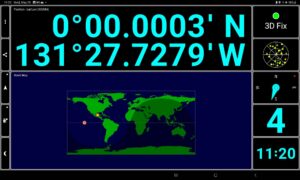
Alarms go off as we cross the 0′. Seems the Raymarine MFD was not happy with switching from N to S. I shut off and restarted the hardware and all was well. Just a little joke by King Neptune!
*NE, E, SE, E and finally NE winds*
The trades were anything but consistent. Sometimes blowing into 20 knots then dying to 8 knots. I kept the Genoa on a stick out as much as possible, however there were times when it was clear I needed my regular genoa setup. I had a total of 3 changes to/from the poled genoa. This showed me the weakness in my pole setup. I really needed a third sheet on the genoa clew.
*The last 100 miles*
The winds went NE on me. I had pulled in the genoa stick which would have been ideal. I kept the genoa full by pointing further south then west and crossed my rhum line on the southing. I was running out of Pacific ocean to adjust my course to Hiva Oa.
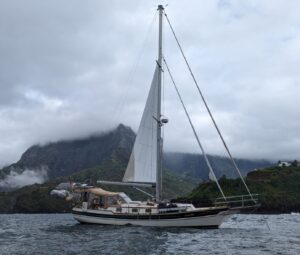
Finally 20 miles north of my turn point south of Hiva Oa, ghosting at 2.5 knots, I decided to fire up the iron sail and motor into Hiva Oa in following seas. Land winds picked up and I sailed into the outer harbor on rolling SE swell. Anchored and took stock of what I had just accomplished.
*Hiva Oa*
I’ll end here at Hiva Oa. Specifically Atuona, which is the main village. Here one can find two very nice markets, a bank machine, a hardware store and at the port, a boat yard capable of handling 28 ton boats.
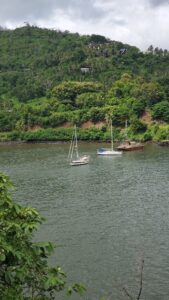
Checking in with my vessel, off boarding crew and my LTS visa was non trivial. I hired Tahiti crew to handle the details. Part of the package was their ability to obtain my cruiser discount for fuel. 25% off. Making fuel about the same cost as in the USA.
That’s all folks. Let the French Polynesia adventure begin!
Comments are closed.
Estrella Sailing Vessel | All Rights Reserved.
Hi Paula congrat’s on your great achivement. More detailed mail will follow.
safe sailing
TnT